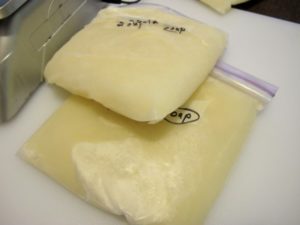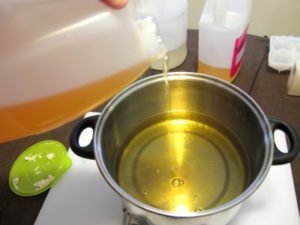Craft soap making is becoming increasingly popular and this beer soap makes the perfect manly gift for a boyfriend or father. The recipe goes well with exfoliants such as course ground coffee, seeds, barley kernels and oats.
What You Will Need:
- 326g (11.5oz) Flat Beer
- 126g (4.6oz) Lye
- Optional Exfoliants – 1/4 Cup Ground Coffee, Seeds, Barley, Oats etc
Oils
- 270g (9.52oz) Olive Oil
- 45g (1.59oz) Castor Oil
- 270g (9.5oz) Coconut Oil
- 180 g (6.35oz) Avocado Oil
- 135g (4.76oz) Shea Butter
Firstly you need to make the beer flat. This can be done in three different ways, open the bottle and wait for a day or two, heat it up in a pot over the stove or pour it into a jug and stir it up every hour or so until it goes flat. Once the beer is flat, pour it into a Ziploc or freezer bag and place it into the freezer until it is solid.
Now weigh out your ingredients paying particular attention to the quantity of lye and oils. Inaccurate measurements will result in a soap which is lye or oil heavy which will have to be thrown out.
Next you need to make you lye solution. Start by breaking up your frozen beer into smaller chucks. Mix the lye into the frozen beer by sprinkling a little over the top and then mixing until it is combined. Do this with small quantities of lye until it has all been dissolved. The lye will slowly react with the beer and produce fumes as well as melt the frozen beer. Do not add too much lye at a time and do not add the beer to the lye as it will cause a violent reaction. Take care not to breath in the fumes and always wear protective gloves.
Prepare you base oils next by melting the Shea butter on the stove over a low heat. Once the butter has melted, remove the pot from the heat and add the liquid oils. Before you mix the oils with the lye solution, you need them to be about the same temperature, around 35 degrees Celsius (95 degrees Fahrenheit). If you have a thermometer, measure the temperature of the oil mixture and allow t to cool to the correct temperature. The lye solution can be heated if necessary in a double boiler until it is the same temperature as the oils.
Now you need to combine the two solutions. Slowly pour the lye solution into the oils while stirring. You need to continue stirring the solution until the mixture reaches a thin trace (thick spirals form in the liquid), this is usually achieved in 5 to 10 minutes. To speed up the mixing, a few pulses of a stick blender in between stirring helps. Mix thoroughly until the mixture turns creamy and begins to thicken.
Once the mixture has thickened, you can mix in the additives. Work quickly as the mixture will continue to thicken and may become too thick to pour. Pour the soap into a bread tin lined with wax wrap or baking paper. Cover the tin with a towel and allow the soap to stand for about a day. During this time the mixture will gel and produce additional heat, keep an eye on the tin as it may be necessary to open the towel up a bit if it gets too hot.
Once the soap has cooled to room temperature and firmed up, you can remove it from the tin and begin cutting it. Cut it into large slices with a sharp kitchen knife. The slices now need to cure for 4 – 6 weeks before they are ready to use, place them on paper towel in a dry, cool and dark place.
Your soap can now be wrapped in paper or cling film and is ready to become your next gift. Try using different types of beer and different exfoliants for a range of different soaps. What are your favorite ingredients to add to your homemade soap? Let us know in the comments below.





Because of the natural ingredients in beer it makes a wonderful creamy, conditioning, lather.
Can this recipe be used for cold process?
This is a cold process recipe. If it were hot process it would be put into a crock pot & cooked.